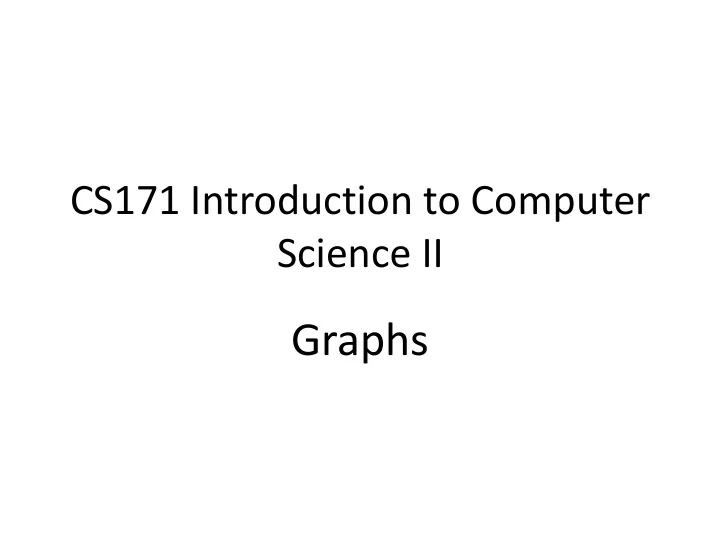

CS171 Introduction to Computer Science II Graphs
Graphs • Simple graphs • Algorithms – Depth-first search – Breadth-first search – shortest path – Connected components • Directed graphs • Weighted graphs • Minimum spanning tree • Shortest path
Edge-weighted graphs • Each connection has an associated weight
Graphs • Simple graphs • Directed graphs • Weighted graphs • Shortest path in weighted digraphs • Symbol graphs • Project discussion • Minimum spanning trees
Dijkstra’s Algorithm • Finds all shortest paths given a source for a graph with nonnegative edge weights • Can be used to solve single destination problem • Intuition: grows the paths from the source node using a greedy approach
Shortest Paths – Dijkstra’s Algorithm • Assign to every node a distance value: set it to zero for source node and to infinity for all other nodes. • Mark all nodes as unvisited. Set source node as current. • For current node, consider all its unvisited neighbors and calculate their tentative distance . If this distance is less than the previously recorded distance, overwrite the distance (edge relaxation). Mark it as visited. • Set the unvisited node with the smallest distance from the source node as the next "current node" and repeat the above • Done when all nodes are visited.
Data structures • Shortest-paths-tree (SPT) is a subgraph containing s as root and all vertices reachable from s and every path is a shortest path. • Two vertex-indexed arrays: – Distance to the source: a vertex-indexed array distTo[] such that distTo[v] is the length of the shortest known path from s to v – Edges on the shortest paths tree: a parent-edge representation of a vertex-indexed array edgeTo[] where edgeTo[v] is the parent edge on the shortest path to v
Dijkstra’s algorithm
MapQuest • Shortest path for a single source-target pair • Dijkstra algorithm can be used 20 15 10 5 15 ? 18 20 25 33
Symbol Graph • Typical applications involve graphs using strings, not integer indices, to define and refer to vertexes – User name in FaceSpace – City name for MapQuest
Better Solution: Make a ‘hunch”! • Use heuristics to guide the search – Heuristic : estimation or “hunch” of how to search for a solution • We define a heuristic function: h(n) = “estimate of the cost of the cheapest path from the starting node to the goal node ”
The A* Search • A* is an algorithm that: – Uses heuristic to guide search – While ensuring that it will compute a path with minimum cost “estimated cost” • A* computes the function f(n) = g(n) + h(n) “actual cost”
A* • f(n) = g(n) + h(n) – g(n) = “cost from the starting node to reach n” – h(n) = “estimate of the cost of the cheapest path from n to the goal node ” h(n) 20 g(n) 15 n 10 5 15 18 20 25 33
Properties of A* • A* generates an optimal solution if h(n) is an admissible heuristic and the search space is a tree: – h(n) is admissible if it never overestimates the cost to reach the destination node • A* generates an optimal solution if h(n) is a consistent heuristic and the search space is a graph: – h(n) is consistent if for every node n and for every successor node n’ of n: h(n) ≤ c(n,n’) + h(n’) h(n) n d c(n,n’) h(n’) n’ • If h(n) is consistent then h(n) is admissible • Frequently when h(n) is admissible, it is also consistent
Admissible Heuristics • A heuristic is admissible if it is optimistic, estimating the cost to be smaller than it actually is. • MapQuest: h(n) = “Euclidean distance to destination” is admissible as normally cities are not connected by roads that make straight lines
Graphs • Simple graphs • Directed graphs • Weighted graphs • Shortest path • Symbol graphs • Project discussion • Minimum spanning trees
Applications • Phone/cable network design – minimum cost • Approximation algorithms for NP-hard problems
Recommend
More recommend